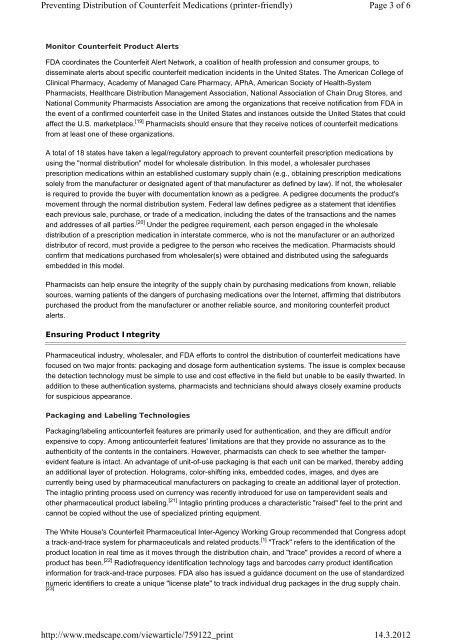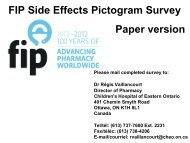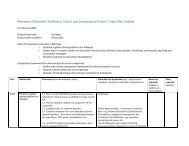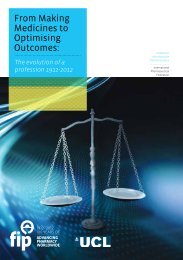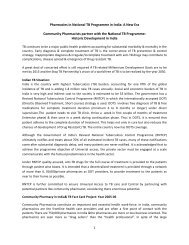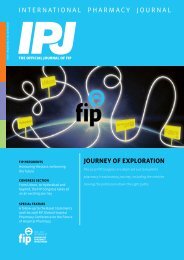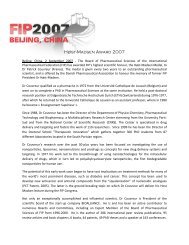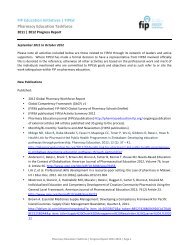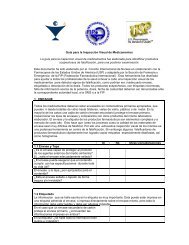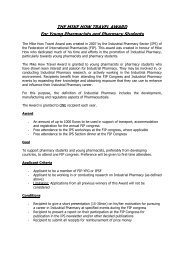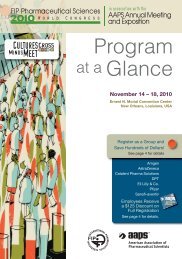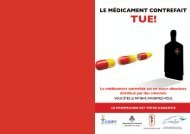Role of the Pharmacist in Preventing Distribution of Counterfeit ... - FIP
Role of the Pharmacist in Preventing Distribution of Counterfeit ... - FIP
Role of the Pharmacist in Preventing Distribution of Counterfeit ... - FIP
Create successful ePaper yourself
Turn your PDF publications into a flip-book with our unique Google optimized e-Paper software.
Prevent<strong>in</strong>g <strong>Distribution</strong> <strong>of</strong> <strong>Counterfeit</strong> Medications (pr<strong>in</strong>ter-friendly)<br />
Monitor <strong>Counterfeit</strong> Product Alerts<br />
FDA coord<strong>in</strong>ates <strong>the</strong> <strong>Counterfeit</strong> Alert Network, a coalition <strong>of</strong> health pr<strong>of</strong>ession and consumer groups, to<br />
dissem<strong>in</strong>ate alerts about specific counterfeit medication <strong>in</strong>cidents <strong>in</strong> <strong>the</strong> United States. The American College <strong>of</strong><br />
Cl<strong>in</strong>ical Pharmacy, Academy <strong>of</strong> Managed Care Pharmacy, APhA, American Society <strong>of</strong> Health-System<br />
<strong>Pharmacist</strong>s, Healthcare <strong>Distribution</strong> Management Association, National Association <strong>of</strong> Cha<strong>in</strong> Drug Stores, and<br />
National Community <strong>Pharmacist</strong>s Association are among <strong>the</strong> organizations that receive notification from FDA <strong>in</strong><br />
<strong>the</strong> event <strong>of</strong> a confirmed counterfeit case <strong>in</strong> <strong>the</strong> United States and <strong>in</strong>stances outside <strong>the</strong> United States that could<br />
affect <strong>the</strong> U.S. marketplace. [19] <strong>Pharmacist</strong>s should ensure that <strong>the</strong>y receive notices <strong>of</strong> counterfeit medications<br />
from at least one <strong>of</strong> <strong>the</strong>se organizations.<br />
A total <strong>of</strong> 18 states have taken a legal/regulatory approach to prevent counterfeit prescription medications by<br />
us<strong>in</strong>g <strong>the</strong> "normal distribution" model for wholesale distribution. In this model, a wholesaler purchases<br />
prescription medications with<strong>in</strong> an established customary supply cha<strong>in</strong> (e.g., obta<strong>in</strong><strong>in</strong>g prescription medications<br />
solely from <strong>the</strong> manufacturer or designated agent <strong>of</strong> that manufacturer as def<strong>in</strong>ed by law). If not, <strong>the</strong> wholesaler<br />
is required to provide <strong>the</strong> buyer with documentation known as a pedigree. A pedigree documents <strong>the</strong> product's<br />
movement through <strong>the</strong> normal distribution system. Federal law def<strong>in</strong>es pedigree as a statement that identifies<br />
each previous sale, purchase, or trade <strong>of</strong> a medication, <strong>in</strong>clud<strong>in</strong>g <strong>the</strong> dates <strong>of</strong> <strong>the</strong> transactions and <strong>the</strong> names<br />
and addresses <strong>of</strong> all parties. [20] Under <strong>the</strong> pedigree requirement, each person engaged <strong>in</strong> <strong>the</strong> wholesale<br />
distribution <strong>of</strong> a prescription medication <strong>in</strong> <strong>in</strong>terstate commerce, who is not <strong>the</strong> manufacturer or an authorized<br />
distributor <strong>of</strong> record, must provide a pedigree to <strong>the</strong> person who receives <strong>the</strong> medication. <strong>Pharmacist</strong>s should<br />
confirm that medications purchased from wholesaler(s) were obta<strong>in</strong>ed and distributed us<strong>in</strong>g <strong>the</strong> safeguards<br />
embedded <strong>in</strong> this model.<br />
<strong>Pharmacist</strong>s can help ensure <strong>the</strong> <strong>in</strong>tegrity <strong>of</strong> <strong>the</strong> supply cha<strong>in</strong> by purchas<strong>in</strong>g medications from known, reliable<br />
sources, warn<strong>in</strong>g patients <strong>of</strong> <strong>the</strong> dangers <strong>of</strong> purchas<strong>in</strong>g medications over <strong>the</strong> Internet, affirm<strong>in</strong>g that distributors<br />
purchased <strong>the</strong> product from <strong>the</strong> manufacturer or ano<strong>the</strong>r reliable source, and monitor<strong>in</strong>g counterfeit product<br />
alerts.<br />
Ensur<strong>in</strong>g Product Integrity<br />
Pharmaceutical <strong>in</strong>dustry, wholesaler, and FDA efforts to control <strong>the</strong> distribution <strong>of</strong> counterfeit medications have<br />
focused on two major fronts: packag<strong>in</strong>g and dosage form au<strong>the</strong>ntication systems. The issue is complex because<br />
<strong>the</strong> detection technology must be simple to use and cost effective <strong>in</strong> <strong>the</strong> field but unable to be easily thwarted. In<br />
addition to <strong>the</strong>se au<strong>the</strong>ntication systems, pharmacists and technicians should always closely exam<strong>in</strong>e products<br />
for suspicious appearance.<br />
Packag<strong>in</strong>g and Label<strong>in</strong>g Technologies<br />
Page 3 <strong>of</strong> 6<br />
Packag<strong>in</strong>g/label<strong>in</strong>g anticounterfeit features are primarily used for au<strong>the</strong>ntication, and <strong>the</strong>y are difficult and/or<br />
expensive to copy. Among anticounterfeit features' limitations are that <strong>the</strong>y provide no assurance as to <strong>the</strong><br />
au<strong>the</strong>nticity <strong>of</strong> <strong>the</strong> contents <strong>in</strong> <strong>the</strong> conta<strong>in</strong>ers. However, pharmacists can check to see whe<strong>the</strong>r <strong>the</strong> tamperevident<br />
feature is <strong>in</strong>tact. An advantage <strong>of</strong> unit-<strong>of</strong>-use packag<strong>in</strong>g is that each unit can be marked, <strong>the</strong>reby add<strong>in</strong>g<br />
an additional layer <strong>of</strong> protection. Holograms, color-shift<strong>in</strong>g <strong>in</strong>ks, embedded codes, images, and dyes are<br />
currently be<strong>in</strong>g used by pharmaceutical manufacturers on packag<strong>in</strong>g to create an additional layer <strong>of</strong> protection.<br />
The <strong>in</strong>taglio pr<strong>in</strong>t<strong>in</strong>g process used on currency was recently <strong>in</strong>troduced for use on tamperevident seals and<br />
o<strong>the</strong>r pharmaceutical product label<strong>in</strong>g. [21] Intaglio pr<strong>in</strong>t<strong>in</strong>g produces a characteristic "raised" feel to <strong>the</strong> pr<strong>in</strong>t and<br />
cannot be copied without <strong>the</strong> use <strong>of</strong> specialized pr<strong>in</strong>t<strong>in</strong>g equipment.<br />
The White House's <strong>Counterfeit</strong> Pharmaceutical Inter-Agency Work<strong>in</strong>g Group recommended that Congress adopt<br />
a track-and-trace system for pharmaceuticals and related products. [1] "Track" refers to <strong>the</strong> identification <strong>of</strong> <strong>the</strong><br />
product location <strong>in</strong> real time as it moves through <strong>the</strong> distribution cha<strong>in</strong>, and "trace" provides a record <strong>of</strong> where a<br />
product has been. [22] Radi<strong>of</strong>requency identification technology tags and barcodes carry product identification<br />
<strong>in</strong>formation for track-and-trace purposes. FDA also has issued a guidance document on <strong>the</strong> use <strong>of</strong> standardized<br />
numeric identifiers to create a unique "license plate" to track <strong>in</strong>dividual drug packages <strong>in</strong> <strong>the</strong> drug supply cha<strong>in</strong>.<br />
[23]<br />
http://www.medscape.com/viewarticle/759122_pr<strong>in</strong>t<br />
14.3.2012


